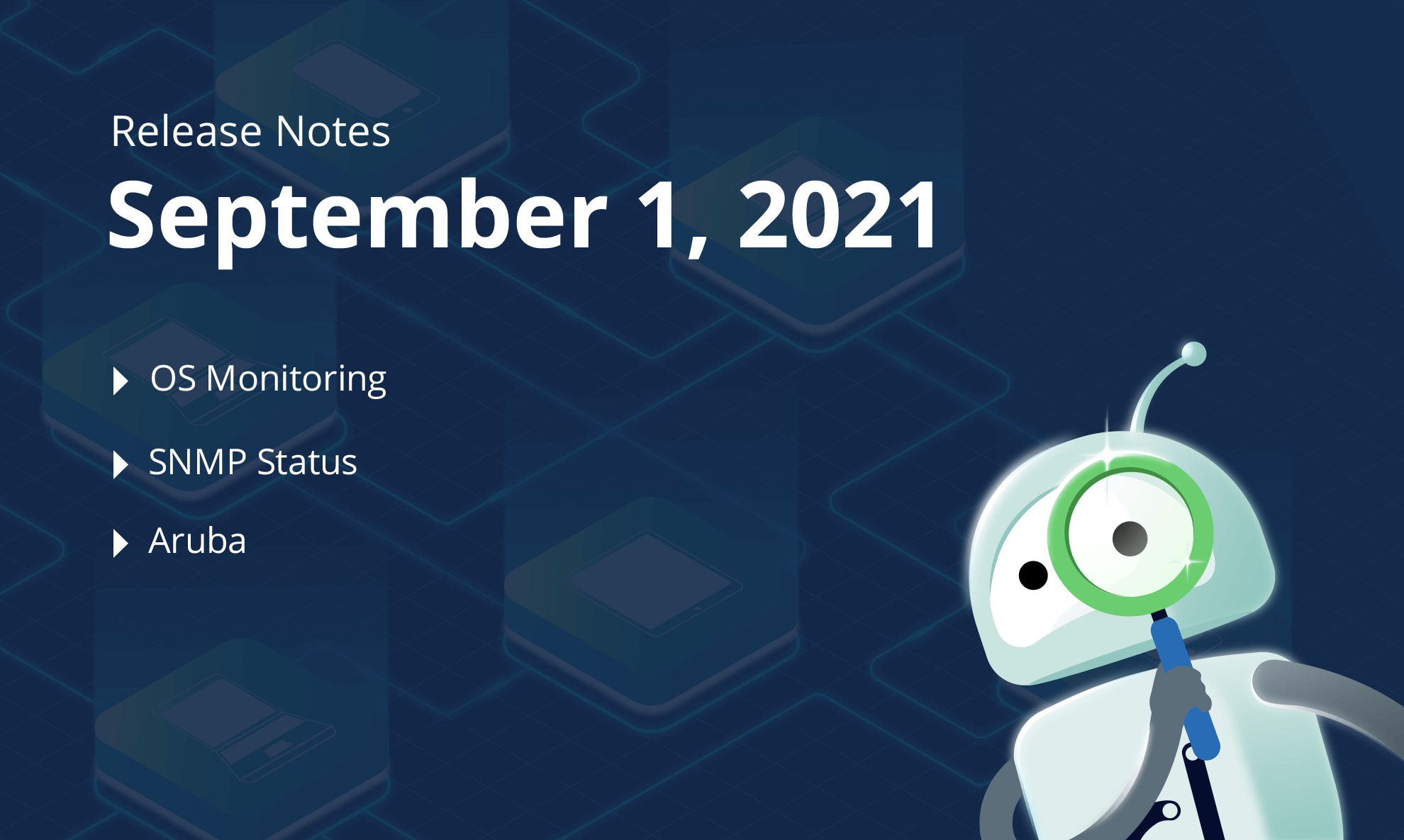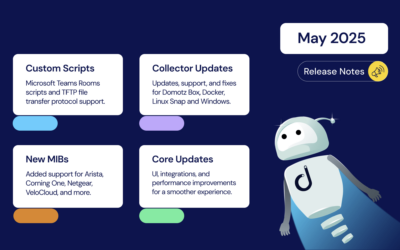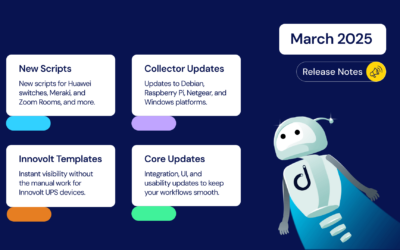Here are the latest features we’ve added to Domotz. Domotz now extracts Operating System information for Windows, macOS and Linux machines. We have introduced the Booster Pack to extend the capabilities offered by the Domotz Agent. SNMP Status and enumerated values are now available. EVO Security can now be used for SSO. Device Uptime is now available within reports. IT Glue links directly from a Device. We’ve also released Configuration Management features for HPE / Aruba networked devices.
What’s new
Operating System Monitoring
Now you can monitor the Operating System information of your Windows, macOS and Linux servers, desktops and laptops:


Information about the Operating System like Family, Vendor, Serial and Build Number, Architecture are now extracted from Servers, Desktops, Laptops and Virtual Machines. This feature relies on either SSH or WinRM protocols which can be enabled on your machines. It does not require administrative accounts on the remote machines.
For more information, visit OS Monitoring feature.
Booster Pack
We’ve added Booster Packs, to extend the capabilities of your Domotz Agent.
Domotz Booster Pack gives you more power to serve larger networks through a single Domotz Agent. On top of the capabilities available on any Domotz Agent, the Booster Pack adds the following features:
+1200 Domotz SNMP sensors
+10GB/month Traffic on Remote Connections
+10 External IP Hosts
+4 Subnets
+10,000/day API calls
For more information, visit Booster Pack.
Improvements
SNMP Monitoring: status Discovery
When configuring SNMP credentials on specific Devices, it is now possible to monitor the status of the service directly from the Device Details view. The following statuses are available when adding SNMP monitoring to a device so you can troubleshoot issues faster:
- Checking
- Reading
- Service Not Found
- Unable to read from SNMP service

For more information, visit SNMP status.
SAML 2.0 / SSO – Support for EVO Security
It is now possible to connect EVO Security as an external SAML 2.0/SSO Authentication mechanism to a Domotz account so that your entire team’s authentication can be managed through a centralized platform.

For more information, visit SAML/SSO Authentication – EVO Security.
Agent Collaboration on Company Reports
Users configured as part of the Company structure can now retrieve the list of all Agents configured under the structure, including details about agents that have been shared with internal or external teams.
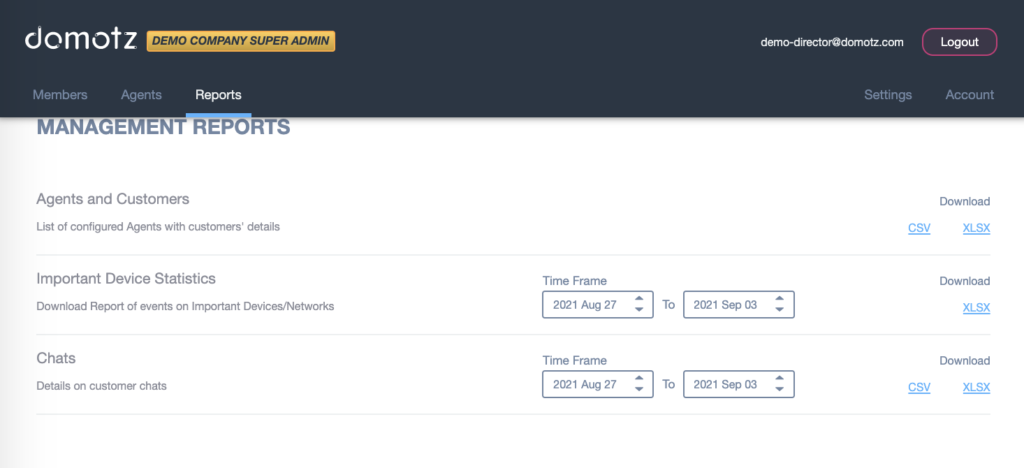
Team Management within Company structure
Users configured as part of the Company structure can now create additional Teams within the structure directly from the Portal:

It is also possible to move Agents from one Team to another:

For more information about Company structure and reports, please contact sales@domotz.com.
Device Uptime in the Monthly PDF Report
The Monthly PDF Report now includes a new column with the uptime percentage of a device during the period of observation:

Device Link to IT Glue
It is now possible to jump directly to IT Glue from the Device Details view of devices connected to an IT Glue Configuration:

For more information, visit IT Glue Integration guide.
Configuration Management: HPE/Aruba
Always stay on top of changes happening on your network infrastructure devices.
With Domotz, you can now automatically backup the running configuration files of your Hewlett Packard Enterprise (HPE) and Aruba Network devices.
Domotz will keep track of the configuration changes over time and notify you if any change occurs. Network configuration issues are easily identified. Store backup files or new configuration files can be pushed to the Network device directly from Domotz.
For more information, visit Network Configuration Management.
Filter for Locked devices
Within the search functionality available in the “Manage” section, it is now possible to filter the devices that need a credential to be set in order to be unlocked:
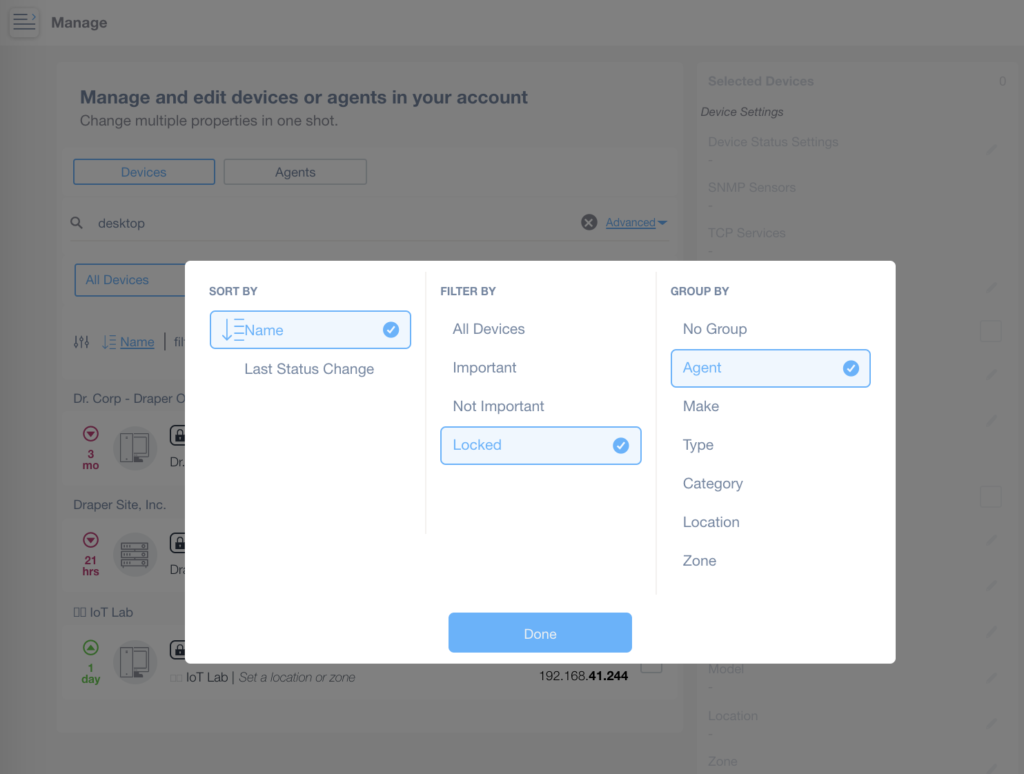
Unlocking devices, guarantees that Domotz uses the most advanced driver to exploit the additional functionalities for monitoring those devices (e.g. Configuration Management for Networking devices, OS Monitoring for Windows, macOS and Linux servers and PC, etc).
Topology Map: data from both devices
Within the Topology Map, when both the upstream and downstream devices are reporting statistics for the same physical connection, the graph only shows one connection. Selecting an upstream or downstream connection is now available. You can then select the source of the information reported (either the upstream or the downstream device):
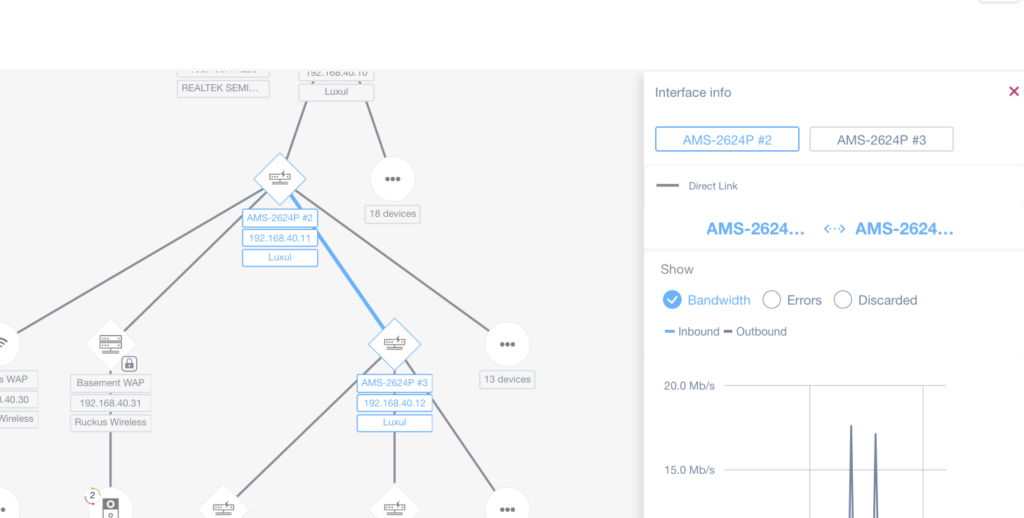
For more information, visit Network Topology Map.
SNMP Monitoring: Enumerated values
To make the process of reading data easier, when monitoring enumerated fields through specific OiDs (MIB identification), Domotz now translate the monitored value into enumerated text:

In the above example, the three OiD are reported as the decipher value as extracted from the MIB. The same values are also used when configuring thresholds for the Alerts.
Stacked Switch details
The interface tab for Managed Network Switches now reports additional information when the data is retrieved through a stacked switch. It now reports each port under the physical switch of the stack.
Unifi Controller Port Mapping
Domotz now extracts and connects more information out of Unifi controllers in order to build a more reliable Network Topology map.
Crestron PDU PC-350 support
The new Crestron PDU (family PC-350) is now supported by Domotz so that you can review and control the outlet status directly from the Domotz App/WebApp.
PoE Switch drivers: Luxul SW-510 and SW-610
The new Luxul PoE switches SW-510 and SW-610 are now supported through Domotz, so that they can be controlled via WebApp or App.
Fix
- When receiving an alert for the WAN IP change, sometimes the old IP Address was not populated
- An issue on the TimeZone conversion prevented the display of RTD data for a few days
- Generic PoE driver (based on RFC 3621) was not able to parse some wrongly formatted data
- Kaseya BMS Integration did not support more than 100 Customers (issue resolved)
- Domotz VPN on Demand Virtual Interface (Tun) was reported in the list of scanned devices
- Under specific circumstances, the Windows agent was triggered to continuously restart
- An error preventing the geo-maps to be loaded on iOS devices has been fixed
- Device identification via Bonjour protocol has been fixed
- Users hosting IT Glue instance in the Australian
- Domotz Portal did not allow the selection (for copy) of any text
Known limitations
- VPN on Demand is currently not supported on Luxul Router based Agents. As soon as Luxul’s team provides Domotz with the API resources to make this available, Domotz will add this capability.
- Devices with multiple network interfaces (multiple MAC addresses) can’t be merged into a single device. This affect also some type of switches which appear as multiple instances on Domotz when VLANs are configured.
- The static IP address on the Domotz Box cannot be configured before configuring the Agent.
- DHCP cannot be leveraged on additional VLANs on the Domotz Box.
This change log covers what’s changed in Domotz Pro service since previous Release Notes. These changes include Domotz Pro cloud, Domotz Agent and Domotz Pro App.
